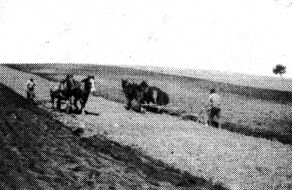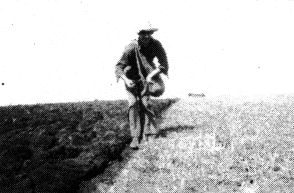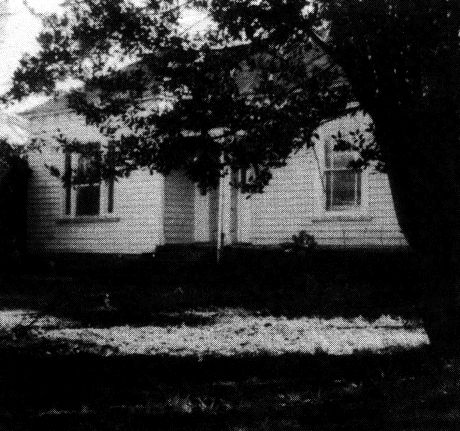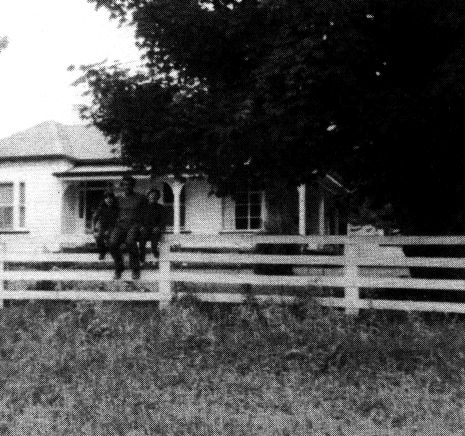Chapter 3 First Business Enterprise
The following year I earned on farming with my father and brothers, and we grew commercial tobacco, but the official advice on the fertiliser which included sulphate of ammonia, was not right for growing cigarette tobacco. Our four acres produced a wonderful crop, but it was really only cheap pipe tobacco.
The tobacco kilns played quite an important role in Scottsdale's future. The Agricultural Department sent Mr. Douglas, the tobacco kiln controlling authority, overseas to investigate the industry, and I was there at the farewell.
He reported that there was no future for tobacco-growing in Tasmania, but he thought there was a big future in the dehydration of vegetables, which had just begun in the U.S.A., and suggested that our kilns and buildings could be converted for that purpose. So the first vegetable dehydration factory in Australia was operated in George Street, Scottsdale, on the site which is now the entrance to the golf course.
Later, when the Federal Govermnent, as a war effort, built 51 dehydration factories in Australia,Scottsdale was assured of being among them. Our factory was built on the opposite side of the road and is now part of the drying, freezing and canning complex of Edgell Birds Eye.
During this period, while working on the farm at home with my father, I learnt to drive bullocks. We borrowed four bullocks and Ron and I bought two Ayrshire steers from my Uncle Hedley. I broke them in and made leaders of them. To do this I paired the steers, put a yoke on their necks and tied their tails together, then put them in the centre of the team and they learnt to work, going forwards, backwards or sideways, depending on how I held the whip. It was necessary at the outset to give them little flips with the whip, but they soon learnt what was expected of them.
Discing, ploughing and harrowing was very slow work with bullocks, but they were strong and inexpensive to feed, and they were of great help with clearing.
Labour was not an important item in those depression years; the most important factor was to keep costs down.
The following year Ron and I began growing potatoes commercially. We forward sold our early varieties at a profitable price, but the actual market was a lot higher.
I purchased all Ron's late variety Brownells, and pitted them in a pyramid-type stack extending in length according to the tonnage available and roofed with cocksfoot straw. This kept the potatoes in an excellent condition for a few months. Now, non-sprouting powder is used on potatoes when stored, and, although that is effective, pitting was a good natural method of keeping potatoes.
After allowing ourselves 1/- (10 cents) an hour for the pitting operation - the ruling rate at the time - I secured a high price in Sydney in an extremely depressed period and managed a penny halfpenny (3 cents) profit on the overall deal of many thousands of sacks of potatoes. However, it was a valuable experience.
We continued to grow potatoes each year, increasing both acreage and tonnage. It was difficult, because we had only £50 ($100) between us when we started and had to do everything on credit. We would rent a paddock and pay for it after the potatoes were dug. Manure and seed also were bought on credit, and we even hired horses for cultivation. However, with very hard work and dedication, we became among the biggest producers of potatoes in Tasmania and even in Australia.
We went to Mr. Edmund Button and asked for a loan of £50 to help us finance the first year's potato growing. He agreed to lend us the money and we decided to call on it as required to save interest.
However, by working very hard and long hours we were able to manage on a loan of only £5. Incidentally, this was the only money I ever borrowed from anyone in my life, although of course I have used bank credit on a considerable scale at various times since.
Mr. George Burrows had great faith in me and offered to lend money if needed, and later Mr. Bob Bird, manager of Herd & Co., offered to lend some of his personal savings.
Uncle Don McLennan later told me he would not have lent us money, but he would have guaranteed an overdraft at the bank. 'Then, son, you are responsible to the bank for paying it back, and personalities do not come into the picture,' he said.
Although I did not use any of these other offers, they did allow me to continue with confidence, for it was a great help to know extra money was available if required. Uncle Don used to say, 'You do not need brains; all you need is horse sense, but very few people have it!'
Ron and I bought our first horse from George Burrows; Roany we called him. Apparently he was a bit of an outlaw, but George said. when we took him, 'G'day boy, you are young and the horse is young, so things will probably workout.' Roany was a terrific horse and we kept him all our potato-growing years.
George Burrows travelled a lot. His main interest was horses, and he never missed a Sydney Show. He went to England and bought stallions, sometimes animals pulling carts in the street, brought them back to Tasmania and later entered them in many agricultural shows, including Sydney. He won many championships with them.
On a trip to New Zealand. he once bought about 30 stallions, which he sought to transport by rail, six horses to each large horsebox. However, the Railway Department would not allow any of the fighting stallions to be together, because it was afraid they would tear the horseboxes apart. So George rode in with the six most vicious horses to stop them fighting!
He had complete control over horses, but unfortunately he was killed by one on his own farm. He was driving his horse and dray across the farm with another horse tied to the top side of the dray. Something frightened the horse he was leading and it tipped the dray over, breaking George's neck. It was a tragic end to a fantastic man, who was a great asset to Scottsdale and Tasmania.
In the late 1930's only horses were used in the Scottsdale district. Against the advice of his father-in-law, George Burrows, Athol Ranson brought the first mechanical rotary hoe into the area, but sold it after a while because he could not get enough work with it. Then, in the early 1940's, with the War and the shortage of labour, tractors started to come into their own.
The first tractor I bought was an Oliver in the early 1940's, when the Americans were pushing mechanisation for large-scale production of vegetables.
When Ron and I began potato growing, ploughing and cultivat- ing was all done with horses, and digging was done with forks. The horse teams used to plough an acre of ground a day, turning over a nine- inch furrow. This represented 11 miles. Ron planted for one team and I for the other. We cut our own potatoes with a knife, leaving a Bismark set with one eye and a Brownell with two.
There was no time to waste when planting; it was very difficult for one man to cut enough potatoes to do a lap of the paddock. In a paddock 10 chains long, up and down was one lap, or 20 chains. The horses and plough covered the lap three times, and the planter twice. The first time, giving the horse a five-chain start (enabling us to finish cutting), we had to jog while carrying a three-quarter bag of potatoes, dropping Bismark sets into the furrow 20 inches apart and Brownell sets 18 inches apart.
By the time the horse had finished this lap we had caught up, and with one-third of a hundredweight of manure over a shoulder went ahead of the horse sowing the manure and endeavouring to gain half a lap in front. While the horse and plough were on the final lap, covering potato sets and manure, we began cutting again for the next lap around.
We harrowed the potatoes every seven days to kill the weeds until the plants were big enough to horsehoe between the rows. Cultivation with the horsehoe was done four or five times at 10-day intervals; they were then moulded once, walking behind the horse and doing a single row at a time.
In the early stages, when the roots were small, we tried to cultivate very deeply, but later, as the roots developed, we lifted the outside tynes, just raking the surface and going deeper only in the centre. In a very dry season the final cultivation before moulding was done with a fine-tooth horsehoe to help retain moisture.
The correct cultivation of potatoes was essential, and, apart from hard work, it was one of the main reasons we were so successful.
In the early stages we couldn't afford wages for chipping out the odd weeds in the crop. If there were a lot we gave our horse an hour for lunch, with plenty of bran and crushed oats, ate our own lunch in 10 minutes, and chipped for the rest of the hour. In this way we were able to get the weeds chipped while the horse had its full rest hour. Digging with forks when the ground was hard demanded strength and skill. You either broke the fork handle, stabbed the potatoes or were very slow until you became a good, seasoned digger.
Picking up potatoes by hand and sorting them also was a back- breaking job. This was really a most important job, because if one potato with one stab hole went into the bag, by the time it reached Sydney, the whole bag would be rotting and the potatoes condemned. And on top of losing a cheque there would still be an account for shipping expenses and other charges.
Ron and I were able to load a motor truck of potatoes in the paddock in 15 to 20 minutes - 105 bags or seven tons. We ran from one bag to another throwing them on the truck three and four bags high without stopping it as it went round and round the paddock.
But the job had the lighter side, for when we had 10 or 12 men working together for six months digging potatoes they made their own fun, playing jokes pn one another. Ours developed into a wonderful team.
One of our team was Ted Diprose, a big man, 6 feet 2 inches tall with very broad shoulders. He was a great chap and a great worker. He was very good-natured, but the chaps used to play on his good nature, sometimes to their sorrow. One of the boys asked Ted whether he was going to the dance one night. Ted, who was 40 years old at the time and single, said 'I'll ask Mum!' His Mum was about 5 feet 1 inch tall. When she passed on, Ted was soon married; the last time I heard, he had been married three times.

Basil Dunkley ploughing with Roany
(our first draught-horse)
and Nobby Cyril Cassidy working
the three horse team in 1943.
This period of potato-growing really gave Ron and me our start. As Henry Ford said in his book, it is the first $1,000 which is the hardest to earn; then money helps to create more. We, of course, still had a long way to go, but we had made $1,000 or better.
Ron and I received very little encouragement when we took up potato-growing. Mr. Percy Brown (father of Col, Sid and Frank) stopped his horse and cart on the road one day to tell us it was economically impossible for us to grow potatoes. He pointed out, quite rightly, that although he was among the best farmers in the district, with very good ground, hard-working, experienced sons, the best horses and the best implements, his potato-growing would not be profitable if he had to pay wages.

Planting potatoes by hand in 1943.
Note my heavy load of potatoes.
He suggested that farmers would rent us only second-class paddocks, and without the necessary knowledge, experience and equipment our ideas were just a boy's pipe dream and would never be anything more. We appreciated Mr. Brown's sincerity, as he thought he was doing us a service.
It is an interesting fact that no time is ever the correct time to start a business. People told us that 20 years before, land and costs were cheaper and that was the better time to start! Now they say 40 years ago was the time to start!
I understand that when Mr. Myer was travelling to Australia by ship he mentioned that he wanted to start a business. Of course, the knowledgable people explained to him that it was impossible, as there were many big established businesses in Australia and a penniless young man would have no hope.
My father told me that Myer earned his first 2/6 by putting up a telephone pole. He then started a store and paid a few pounds to various people in Melbourne to stop others in the street and ask directions to Myer's Store. Although they had never heard of Myer's, they were now interested and discussed at home that everyone they met seemed to wish to go to Myer's. It was a very simple, inexpensive form of advertising. Now this firm has a turnover of billions!
Coles Bros., farmers from North-Western Tasmania, decided on returning from World War 1 to open a store which sold only items costing no more than 2/6, and this limit was maintained for many years before rising prices made the practice uneconomic. Then they had to start charging 2/6 for each boot, for instance. They then expanded, and today they have the biggest turnover of any company in Australia. Coles and Myer's have now amalgamated and have become Coles-Myer.
Recently Roelf Vos sold his store chain for some 40 million dollars. I understand he painted footsteps to his first store on the streets of Launceston and, although his action was frowned upon by officialdom, it was good publicity.
Another recent example of an individual who has made good is Joe Chromy, who controls Blue Ribbon Products. He started with nothing when it seemed impossible to compete with such big meat processors as Borthwicks, Huttons and others. Now I guess he is the biggest private operator in Tasmania, although Hawkridge and Gilbertsons are bigger companies. The meat industry in Victoria and Tasmania owes a lot to the Gilbertsons. They really are a tenific family.
But a warning is timely here. The Americans have a saying, 'Shirt sleeves to shirt sleeves in three generations.' The first generation earn a fortune, the second generation get things too easily and are a bit soft, and the third generation are spoilt and they crash. However, this sequence of events will not always happen. Seabrook and Kaiser's, about which we will talk later, provide a good example of fantastic progress and then a modest decline.
Early in the 1940's a vegetable seed company was formed, with Mr. Harold Bushby as chairman. It was only a small company and he suggested a starting capital of £1,000. I suggested he put a nought on the end of it, making it £10,000, and after looking around the room I could see that £10,000 would be insufficient, so I said, 'Excuse me, Mr. Chairman, add another nought.' Many times since Merv. McLennan has ribbed me about my barrow-load of noughts! The seed company never really got off the ground.
Ron and I grew potatoes on rented ground throughout the district for about three years, then bought 250 acres of chocolate soil at West Scottsdale from Jessup and Lawes. We actually bought it because of a mulberry tree. It was a very hot day and after walking around the farm we were tired and, discouraged by the amount of twitch everywhere, decided not to buy. But a feed of mulberries from a laden tree in the garden refreshed us bodily and spiritually, and we changed our minds.
We farmed in partnership until 1941, when Ron, with his wife Nell and their two children, moved to Winnaleah. I stayed on at West Scottsdale, and Peg and I were married in 1942. Peggy was the daughter of Harry and Alma Spotswood and the eldest of three girls and one boy. When we were married, Harry was Lieutenant-Colonel of the l2th/5Oth Battalion at the Elphin Showgrounds. Before and after the war he was Council Clerk at Scottsdale.
We remained at West Scottsdale for eight years, during which time Sue, Helen and Mary were born. In the early days, Peg often pushed the pram four miles into Scottsdale.

Our home at West Scottsdale when we were first married.
We put a water supply on to the West Scottsdale property by erecting a big concrete tank and installing an electric pump, which allowed us to have a septic tank. I think an automatic flushing system which gives good toilet facilities is the most important thing in the home.
Improvements made by Ron and Nell and then ourselves made it a very nice home. It is now owned by Graeme and Jenny Millwood and it is a beautiful old home with lovely antique furniture and a large garden.
The house used to belong to Harry Jessup, who had two sons, Ray and Eric, and daughters Doris and Kathleen. The Jessups were a very clever family, but not necessarily the best farmers. Ray became one of the best practical engineers in Australia, specialising in dredging contracts. He designed a big proportion of his own equip- ment, and he and his partner carried out most of the big dredging jobs throughout the Commonwealth in the 1950's and 60's. Later he worked in a consulting capacity and represented Australia on a three- man team which went to Indonesia and then China.
One of Ray's recent projects was advising on the dredging of Shanghai Harbour. He and two Americans estimated that the mud in Shanghai Harbour was 60 feet deep - silt from the Yellow River. The estimated cost of the dredging project was to be one billion dollars. Ray has also done big jobs in Singapore and Hong Kong. He was truly and amazing man, though very modest. He died recently.
In 1950 I sold out, exchanging farms with Mr. R.C. Field. I took his Scottsdale properties and Mr. Tom Field and his wife Betty moved to West Scottsdale.

It is now Millwood's home.
Pictured are Graeme, Jackie and Matthew.
While we were waiting 18 months for our present home to be built, we lived with Peg's parents at 'The Blackwoods', in King Street, Scottsdale, and during that time Jeannie was born. Our home was built off George Street on land purchased from Athol McLennan.
At this period of our potato-growing, wages were very low throughout the country and there were no awards for farm workers - or if there were, no one knew of them and no holidays were paid. My staff were doing a terrific job at West Scottsdale, so I decided to pay for holidays. I think I was the first farmer in the state, or at least in our area, to pay for farm holidays.
This annoyed one of my neighbours, who came and told me off for paying for public holidays. Actually, he was not employing any men, but was annoyed to see my chaps having the day off on full pay while he said he had to work to meet the bills! Things certainly have changed now in regard to labour awards - and I think quite rightly so.